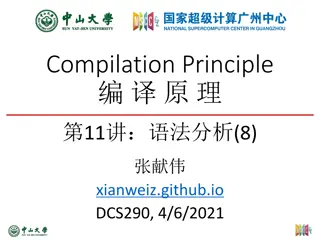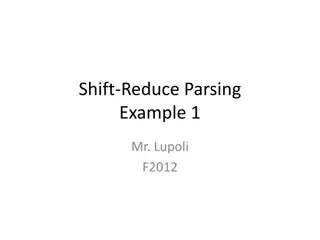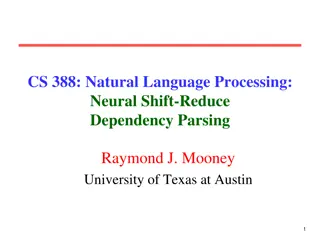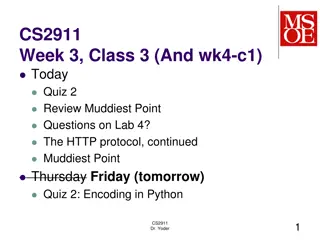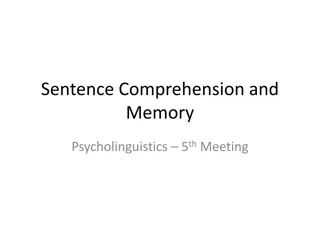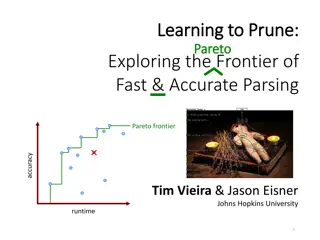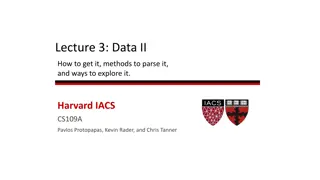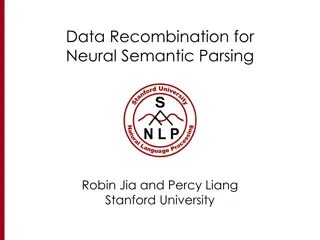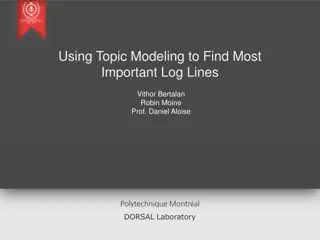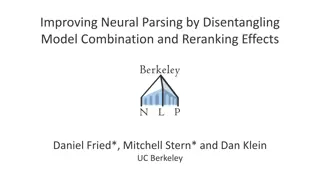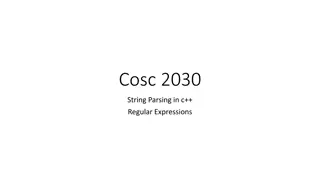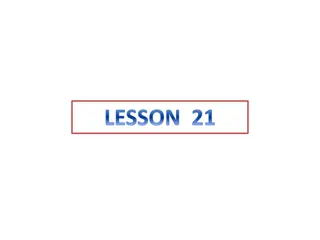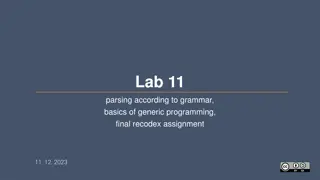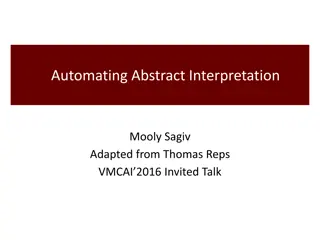
Syntactic Structure in Natural Language Processing
Explore the two key views of syntactic structure in statistical natural language parsing and linguistic analysis by Christopher Manning. Discover how phrase structure and dependency structure play essential roles in organizing linguistic elements. Delve into the evolution of NLP parsing from classical approaches to modern data-driven methodologies.
Download Presentation

Please find below an Image/Link to download the presentation.
The content on the website is provided AS IS for your information and personal use only. It may not be sold, licensed, or shared on other websites without obtaining consent from the author. If you encounter any issues during the download, it is possible that the publisher has removed the file from their server.
You are allowed to download the files provided on this website for personal or commercial use, subject to the condition that they are used lawfully. All files are the property of their respective owners.
The content on the website is provided AS IS for your information and personal use only. It may not be sold, licensed, or shared on other websites without obtaining consent from the author.
E N D
Presentation Transcript
Statistical Natural Language Parsing Two views of syntactic structure
Christopher Manning Two views of linguistic structure: 1. Constituency (phrase structure) Phrase structure organizes words into nested constituents. How do we know what is a constituent? (Not that linguists don t argue about some cases.) Distribution: a constituent behaves as a unit that can appear in different places: John talked [to the children] [about drugs]. John talked [about drugs] [to the children]. *John talked drugs to the children about Substitution/expansion/pro-forms: I sat [on the box/right on top of the box/there]. Coordination, regular internal structure, no intrusion, fragments, semantics,
Christopher Manning Headed phrase structure VP VB* NP NN* ADJP JJ* ADVP RB* SBAR(Q) S|SINV|SQ NP VP Plus minor phrase types: QP (quantifier phrase in NP), CONJP (multi word constructions: as well as), INTJ (interjections), etc.
Christopher Manning Two views of linguistic structure: 2. Dependency structure Dependency structure shows which words depend on (modify or are arguments of) which other words. The boy put the tortoise on the rug
Statistical Natural Language Parsing Two views of syntactic structure
Statistical Natural Language Parsing Parsing: The rise of data and statistics
Christopher Manning Pre 1990 ( Classical ) NLP Parsing Wrote symbolic grammar (CFG or often richer) and lexicon S NP VP NN interest NP (DT) NN NNS rates NP NN NNS NNS raises NP NNP VBP interest VP V NP VBZ rates Used grammar/proof systems to prove parses from words This scaled very badly and didn t give coverage. For sentence: Fed raises interest rates 0.5% in effort to control inflation Minimal grammar: Simple 10 rule grammar: Real-size broad-coverage grammar: millions of parses 36 parses 592 parses
Christopher Manning Classical NLP Parsing: The problem and its solution Categorical constraints can be added to grammars to limit unlikely/weird parses for sentences But the attempt make the grammars not robust In traditional systems, commonly 30% of sentences in even an edited text would have no parse. A less constrained grammar can parse more sentences But simple sentences end up with ever more parses with no way to choose between them We need mechanisms that allow us to find the most likely parse(s) for a sentence Statistical parsing lets us work with very loose grammars that admit millions of parses for sentences but still quickly find the best parse(s)
Christopher Manning The rise of annotated data: The Penn Treebank [Marcus et al. 1993, Computational Linguistics] ( (S (NP-SBJ (DT The) (NN move)) (VP (VBD followed) (NP (NP (DT a) (NN round)) (PP (IN of) (NP (NP (JJ similar) (NNS increases)) (PP (IN by) (NP (JJ other) (NNS lenders))) (PP (IN against) (NP (NNP Arizona) (JJ real) (NN estate) (NNS loans)))))) (, ,) (S-ADV (NP-SBJ (-NONE- *)) (VP (VBG reflecting) (NP (NP (DT a) (VBG continuing) (NN decline)) (PP-LOC (IN in) (NP (DT that) (NN market))))))) (. .)))
Christopher Manning The rise of annotated data Starting off, building a treebank seems a lot slower and less useful than building a grammar But a treebank gives us many things Reusability of the labor Many parsers, POS taggers, etc. Valuable resource for linguistics Broad coverage Frequencies and distributional information A way to evaluate systems
Statistical Natural Language Parsing Parsing: The rise of data and statistics
Statistical Natural Language Parsing An exponential number of attachments
Christopher Manning Attachment ambiguities A key parsing decision is how we attach various constituents PPs, adverbial or participial phrases, infinitives, coordinations, etc. Catalan numbers: Cn = (2n)!/[(n+1)!n!] An exponentially growing series, which arises in many tree-like contexts: E.g., the number of possible triangulations of a polygon with n+2 sides Turns up in triangulation of probabilistic graphical models .
Christopher Manning Two problems to solve: 1. Repeated work
Christopher Manning Two problems to solve: 2. Choosing the correct parse How do we work out the correct attachment: She saw the man with a telescope Is the problem AI complete ? Yes, but Words are good predictors of attachment Even absent full understanding Moscow sent more than 100,000 soldiers into Afghanistan Sydney Water breached an agreement with NSW Health Our statistical parsers will try to exploit such statistics.
Statistical Natural Language Parsing An exponential number of attachments

